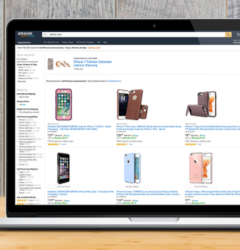Selling on Amazon offers two primary pathways: Amazon Seller Central and Amazon Vendor Central. Each pathway provides unique features, benefits, and operational models tailored to different types of sellers and business strategies. Understanding the distinctions between these platforms can help you choose the best one for your business, ensuring optimal growth, control, and profitability.
Why Choose Between Seller Central and Vendor Central?
Choosing between Amazon Seller Central and Amazon Vendor Central is crucial for your business strategy on Amazon. Each platform offers distinct advantages and operates differently, impacting how you sell, manage, and grow your business. Understanding these differences will help you leverage the right platform to maximize your sales and operational efficiency.
- Amazon Seller Central allows businesses to sell products directly to consumers on Amazon. Here, you have complete control over your product listings, pricing, and inventory, and can engage directly with customers. It’s ideal for businesses that want to maintain autonomy over their sales and brand presentation.
- Amazon Vendor Central, on the other hand, involves selling your products to Amazon in bulk, where Amazon then sells these products to end customers. This platform is often invitation-only and suits large manufacturers and distributors who prefer a hands-off approach, allowing Amazon to manage logistics, pricing, and customer service.
Discover the Main Differences and Why It Matters for Your Business
Choosing the right platform between Amazon Seller Central and Vendor Central can significantly impact your business’s success on Amazon. Each platform has unique features, benefits, and potential drawbacks, and the right choice depends on your specific business needs and goals.
- Amazon Seller Central provides more control over your business operations. You manage inventory, pricing, and customer interactions directly. This platform suits businesses that want to maintain flexibility and direct oversight over their Amazon operations. By managing your listings and prices, you can respond quickly to market trends, promotions, and competition, ensuring that your products remain competitive.
- Amazon Vendor Central, however, simplifies many aspects of selling on Amazon by handling logistics, pricing, and customer service. This can be advantageous for large manufacturers and distributors who want to focus on production and supply rather than the day-to-day operations of e-commerce. Vendor Central can offer more stability in terms of order volume and reduces the operational burden on your team.
Understanding these differences and how they align with your business strategy is crucial. Whether you prioritize control and flexibility (Seller Central) or prefer a more hands-off approach with robust support from Amazon (Vendor Central), making an informed decision will help you optimize your presence and success on Amazon.
Amazon Seller Central is a self-service platform designed for businesses of all sizes to sell their products directly to Amazon’s vast customer base. Here, you act as a third-party seller, managing your product listings, prices, inventory, and customer interactions.
Key Features and Benefits of Seller Central
Inventory Management
As a seller, you have full control over your inventory. You decide how much stock to hold and when to reorder, allowing you to respond quickly to changes in demand.
Order Fulfillment
You can choose to handle shipping yourself (Merchant Fulfilled Network, MFN) or use Fulfillment by Amazon (FBA), where Amazon takes care of storage, packing, and shipping for a fee.
Customer Service Tools
Seller Central provides tools to help you manage customer inquiries and returns, ensuring you can maintain high customer satisfaction levels.
Marketing and Advertising Options
Sellers have access to a variety of advertising tools, such as Sponsored Products, Sponsored Brands, and Sponsored Display ads, to promote their products and increase visibility on Amazon.
Sales Reporting and Analytics
Detailed analytics are available to track sales performance, understand customer behavior, and optimize your listings and pricing strategies.
Why Control Matters: Inventory, Pricing, and Listings
- Inventory Management: With Seller Central, you can monitor and adjust your inventory levels in real-time, ensuring you always have the right amount of stock. This flexibility helps prevent stockouts and overstock situations, which can impact sales and storage costs.
- Pricing Control: Sellers on Seller Central set their own prices, allowing them to adjust to market conditions, offer promotions, and maximize profit margins. This control is crucial for responding to competitor pricing and market trends quickly.
- Product Listings: You have full control over how your products are presented on Amazon. This includes writing product descriptions, selecting images, and optimizing your listings for SEO, which can significantly impact your product’s visibility and sales performance.
Amazon Vendor Central is an invitation-only platform designed for manufacturers, distributors, and other large-scale businesses to sell their products wholesale directly to Amazon. Once Amazon buys these products, it sells them to end customers. This platform is ideal for companies looking for a more hands-off approach to selling on Amazon, as Amazon handles many aspects of the sales process, including pricing, logistics, and customer service.
Key Features and Benefits of Vendor Central
Bulk Product Management
Vendors can list and manage products in bulk, which simplifies inventory management and order fulfillment. This is particularly beneficial for businesses with large product catalogs.
Direct Payments
Vendors receive payments directly from Amazon. This means vendors don’t have to wait for customer payments and can manage their cash flow more predictably.
Amazon-Managed Shipping and Customer Service
Amazon takes care of all logistics, from warehousing to shipping and even customer service. This includes handling returns and customer inquiries, which can save vendors significant time and resources.
Access to Marketing Tools
Vendors have access to advanced marketing tools such as Amazon Vine, which allows selected customers to post reviews for new products, and A+ Content, which enables vendors to create more engaging product detail pages with enhanced content.
Sales Reporting and Analytics
While more limited compared to Seller Central, vendors still have access to basic sales and inventory data, allowing them to track product performance and make informed decisions.
Hands-Off Selling: How Amazon Manages Everything
One of the most significant advantages of Amazon Vendor Central is the hands-off approach it offers. Here’s how Amazon manages the key aspects of the selling process:
- Pricing: Amazon sets the retail price for products. This can be advantageous because Amazon often has a sophisticated pricing strategy aimed at maximizing sales and profitability.
- Inventory Management: Once Amazon purchases the inventory, it manages warehousing and stock levels. This means vendors do not have to worry about maintaining stock or dealing with excess inventory.
- Shipping: Amazon handles the packing and shipping of products to customers, ensuring timely delivery. This includes leveraging Amazon’s extensive logistics network to optimize delivery times and costs.
- Customer Service: Amazon’s customer service team manages all customer inquiries, returns, and complaints. This ensures that customers receive consistent and high-quality service, enhancing the overall customer experience.
This hands-off approach can be particularly beneficial for businesses that prefer to focus on product development and manufacturing, rather than the day-to-day operations of e-commerce.
Pros and Cons: A Deep Dive into Each Platform
Understanding the detailed pros and cons of Amazon Seller Central and Amazon Vendor Central is crucial for making an informed decision about which platform to use. Each has its own set of advantages and challenges that can significantly impact your business operations and profitability.
Amazon Seller Central: In-Depth Pros and Cons
Pros
1. Control Over Pricing and Listings:
- Sellers have full control over pricing strategies, allowing for dynamic adjustments based on market conditions and competition. This control enables sellers to maximize profit margins and respond quickly to market trends.
2. Direct Customer Interaction:
- Sellers can engage directly with customers, handling inquiries, feedback, and returns. This direct interaction helps build customer relationships, enhances brand loyalty, and provides valuable insights into customer preferences and behavior.
3. Flexible Fulfillment Options:
- Sellers can choose between handling logistics themselves (Merchant Fulfilled Network, MFN) or using Fulfillment by Amazon (FBA). FBA simplifies the fulfillment process by outsourcing warehousing, packing, and shipping to Amazon, freeing up resources for the seller.
4. Comprehensive Analytics and Reporting:
- Seller Central provides detailed sales data, customer insights, and performance analytics. These tools help sellers optimize listings, adjust marketing strategies, and make data-driven decisions to improve overall sales performance.
Cons
1. High Competition:
- The platform’s accessibility means that many sellers compete for visibility and sales. This high level of competition requires constant optimization of listings, pricing, and marketing strategies to stay ahead.
2. Various Fees:
- Sellers must pay several fees, including referral fees, closing fees, and potential FBA fees. These fees can add up, affecting profit margins, especially for low-margin products.
3. Responsibility for Customer Service:
- Unless using FBA, sellers are responsible for handling all customer service aspects, including addressing inquiries, managing returns, and resolving complaints. This responsibility can be time-consuming and resource-intensive.
4. Inventory Management:
- Sellers must manage their own inventory, ensuring they have adequate stock levels to meet demand. This requires effective inventory forecasting and management to avoid stockouts or overstock situations.
Amazon Vendor Central: In-Depth Pros and Cons
Pros
1. Less Competition:
- Vendor Central is an invitation-only platform, reducing the number of competitors. This exclusivity can lead to higher visibility and potentially more sales for vendor products.
2. Simplified Logistics and Fulfillment:
- Amazon handles all aspects of logistics, including warehousing, packing, and shipping. This hands-off approach allows vendors to focus on production and supply chain management without worrying about fulfillment complexities.
3. Increased Customer Trust:
- Products sold directly by Amazon often carry the “Ships from and sold by Amazon.com” label, which can enhance customer trust and potentially increase sales. Customers may prefer purchasing products sold by Amazon due to the perceived reliability and support.
4. Access to Advanced Marketing Tools:
- Vendors have access to powerful marketing tools such as Amazon Vine for early product reviews and A+ Content to create enriched product detail pages. These tools can improve product visibility, credibility, and conversion rates.
Cons
1. Less Control Over Pricing and Listings:
- Amazon sets the retail prices for vendor products, limiting the vendor’s ability to influence pricing strategies. Additionally, Amazon may modify product listings, which can affect brand presentation and consistency.
2. Strict Logistic Requirements:
- Vendors must comply with Amazon’s stringent logistical requirements. Failure to meet these requirements can result in penalties or chargebacks, impacting profitability.
3. Longer Payment Terms:
- Payment terms are typically on a Net 60 basis, meaning vendors may have to wait up to two months to receive payment for their sales. This can impact cash flow, especially for smaller vendors.
4. Potential Lower Margins:
- Selling to Amazon at wholesale prices can result in lower profit margins compared to direct-to-consumer sales. Vendors need to consider the impact of wholesale pricing on their overall profitability.
Comparing Seller Central and Vendor Central: What You Need to Know
Choosing between Amazon Seller Central and Vendor Central depends on various factors, including control over inventory, pricing, product listings, logistics, and advertising opportunities. This section highlights the key differences to help you make an informed decision.
Who Owns the Inventory?
- Amazon Seller Central: In Seller Central, the seller maintains ownership of the inventory. This means you are responsible for storing, managing, and shipping the products unless you use Fulfillment by Amazon (FBA). With FBA, Amazon takes care of warehousing and fulfillment, but you still own the inventory until it is sold.
- Amazon Vendor Central: In Vendor Central, Amazon purchases the inventory from the vendor. Once the transaction is complete, Amazon owns the inventory and is responsible for storing, managing, and shipping the products to customers. This reduces the burden of inventory management for the vendor but also means relinquishing control over the stock.
How Pricing and Profit Margins Differ
- Amazon Seller Central: Sellers on Seller Central have complete control over pricing. You can set your prices, run promotions, and adjust prices based on market demand and competition. This flexibility allows you to maximize profit margins but requires active management to stay competitive.
- Amazon Vendor Central: In Vendor Central, Amazon sets the retail prices. Vendors sell their products to Amazon at wholesale prices, which can result in lower profit margins compared to direct-to-consumer sales. While this simplifies pricing strategies, it also means vendors have less influence over how their products are priced on the marketplace.
Control Over Product Listings: What’s the Difference?
- Amazon Seller Central: Sellers have full control over their product listings. This includes creating and optimizing product titles, descriptions, images, and keywords. Effective listing optimization can improve search visibility and conversion rates, giving sellers a competitive edge.
- Amazon Vendor Central: Amazon has more control over product listings in Vendor Central. While vendors can provide product information and images, Amazon may modify the listings to meet their standards and optimize for sales. This can lead to inconsistencies with brand messaging and presentation.
Logistics and Order Fulfillment: Which is Easier?
- Amazon Seller Central: Sellers can choose between handling logistics themselves (Merchant Fulfilled Network, MFN) or using FBA. With MFN, sellers are responsible for storing, packing, and shipping orders. FBA simplifies this by allowing Amazon to handle these tasks, but it comes with additional fees.
- Amazon Vendor Central: Amazon handles all logistics and order fulfillment. Once Amazon buys the inventory, they store, pack, and ship the products to customers. This hands-off approach can significantly reduce the operational burden on vendors, making it easier to manage large volumes of orders.
Advertising and Marketing Opportunities: Which Platform Wins?
- Amazon Seller Central: Sellers have access to various advertising tools, including Sponsored Products, Sponsored Brands, and Sponsored Display ads. These tools help increase product visibility and drive sales. Additionally, sellers can create promotions and use Amazon Stores to build a branded shopping experience.
- Amazon Vendor Central: Vendors also have access to advanced marketing tools, such as Amazon Vine for early product reviews and A+ Content to enhance product detail pages. These tools can help improve product visibility and credibility. However, vendors may have less flexibility in running promotions compared to Seller Central.
Summary of Key Differences
| Aspect |
Seller Central |
Vendor Central |
| Inventory Ownership |
Seller |
Amazon |
| Pricing Control |
Seller |
Amazon |
| Product Listing Control |
Seller |
Amazon |
| Logistics & Fulfillment |
Seller (or FBA) |
Amazon |
| Advertising Opportunities |
Sponsored Products, Sponsored Brands, Display Ads |
Amazon Vine, A+ Content, Marketing Services |
Making the Decision: Which Platform is Best for Your Business?
Deciding between Amazon Seller Central and Vendor Central requires a careful evaluation of your business needs, resources, and goals. This section provides a comprehensive guide on how to make the right choice based on several critical factors.
Considering Your Business Size and Resources
Small to Medium-Sized Businesses
Seller Central: This platform is typically more suitable for small to medium-sized businesses. It allows for more control over pricing, inventory, and customer interactions. The initial costs are lower, and businesses can scale their operations gradually. Seller Central is ideal if you have the resources to manage listings, pricing, and fulfillment yourself, or if you prefer to use FBA to handle logistics.
Large Manufacturers and Distributors
Vendor Central: Larger businesses with substantial manufacturing capabilities might find Vendor Central more appealing. This platform simplifies logistics and customer service, allowing you to focus on production and supply chain management. If your business can handle the stringent requirements and longer payment terms, Vendor Central can offer significant benefits through Amazon’s extensive reach and marketing tools.
Deciding on the Level of Control You Need
High Level of Control
Seller Central: If maintaining control over pricing, product listings, and direct customer interactions is crucial for your business, Seller Central is the better choice. You can dynamically adjust prices, create detailed and optimized product listings, and engage directly with your customers, which can enhance brand loyalty and customer satisfaction.
Hands-Off Approach
Vendor Central: For businesses that prefer a more hands-off approach, Vendor Central is advantageous. Amazon takes over pricing, logistics, and customer service, which can significantly reduce the operational burden. This approach is beneficial if your primary focus is on manufacturing and scaling production without the complexities of managing direct sales and customer interactions.
Evaluating Your Logistics and Customer Service Capabilities
Managing Logistics and Customer Service
- Seller Central: This platform requires sellers to handle their own logistics and customer service unless they opt for FBA. If your business has the capability to manage warehousing, shipping, and customer support, or if you’re willing to invest in FBA, Seller Central offers the flexibility and control needed to maintain high service standards.
Outsourcing Logistics and Customer Service
- Vendor Central: With Amazon handling all logistics and customer service aspects, Vendor Central is ideal for businesses that want to offload these responsibilities. This can be particularly beneficial for companies with large product volumes or those that lack the infrastructure to manage these functions efficiently.
Summary Table for Decision Factors
| Factor |
Seller Central |
Vendor Central |
| Business Size |
Small to medium-sized businesses |
Large manufacturers and distributors |
| Control Over Operations |
High control over pricing and listings |
Hands-off approach with Amazon control |
| Logistics Management |
Self-managed or FBA |
Amazon-managed logistics |
| Customer Service |
Direct management or FBA |
Amazon-managed customer service |
| Initial Costs |
Lower initial costs |
Potentially higher due to stringent requirements |
| Payment Terms |
Shorter payment cycles |
Longer payment terms (Net 60) |
Conclusion: Choosing the Right Path for Success on Amazon
Deciding between Amazon Seller Central and Vendor Central is a significant choice that can influence the trajectory of your business on Amazon. Each platform has distinct advantages and disadvantages that cater to different types of businesses and operational strategies.
Summarizing the Key Differences
Amazon Seller Central
- Control: Provides extensive control over pricing, listings, and customer interactions.
- Flexibility: Offers flexible fulfillment options, either through Merchant Fulfilled Network (MFN) or Fulfillment by Amazon (FBA).
- Competition: High competition due to the open nature of the platform.
- Fees: Various fees including referral fees, closing fees, and FBA fees.
- Customer Service: Sellers handle customer service unless using FBA.
Amazon Vendor Central
- Control: Amazon controls pricing, product listings, and customer service.
- Simplicity: Amazon handles logistics, inventory management, and fulfillment.
- Competition: Less competition due to the invitation-only model.
- Payment Terms: Typically longer payment terms (Net 60).
- Marketing Tools: Access to advanced marketing tools like Amazon Vine and A+ Content.
Final Recommendations: Seller Central vs. Vendor Central
For Small to Medium-Sized Businesses
- Seller Central is generally more suitable due to the control it offers over pricing, product listings, and customer interactions. It allows these businesses to build their brand and maintain direct relationships with customers. The flexibility in fulfillment options (MFN or FBA) is also beneficial for managing logistics according to their resources and capabilities.
For Large Manufacturers and Distributors
- Vendor Central is ideal for larger businesses that produce goods in high volumes and prefer to sell wholesale. The hands-off approach to logistics and customer service, managed by Amazon, can significantly reduce operational burdens. The increased trust and visibility associated with products sold directly by Amazon can also enhance sales potential.
Frequently Asked Questions
-
What fees are associated with Amazon Seller Central and Vendor Central?
- Seller Central: Referral fees, closing fees, and FBA fees if applicable. Professional sellers also pay a monthly subscription fee.
- Vendor Central: Vendors may face slotting and marketing fees, along with potential chargebacks for failing to meet Amazon’s requirements.
-
How does pricing control affect profit margins on each platform?
- Seller Central: Sellers can set their own prices, allowing them to optimize profit margins based on market conditions and competition.
- Vendor Central: Amazon sets the prices, which may result in lower margins since products are sold at wholesale prices to Amazon.
-
What marketing tools are available for each type of account?
- Seller Central: Sponsored Products, Sponsored Brands, Sponsored Display ads, and Amazon Stores.
- Vendor Central: Amazon Vine, A+ Content, and Amazon Marketing Services.
-
How can you manage inventory efficiently on Seller Central and Vendor Central?
- Seller Central: Use real-time inventory management tools and consider FBA for outsourced logistics.
- Vendor Central: Amazon handles inventory management once the products are purchased, reducing the vendor’s burden.
-
What factors should you consider when deciding between Seller Central and Vendor Central?
- Consider your business size, control needs, logistics capabilities, and customer service preferences. Evaluate the trade-offs between control and convenience, and choose the platform that aligns with your strategic goals.
By carefully considering these factors and understanding the key differences between Amazon Seller Central and Vendor Central, businesses can choose the platform that best supports their operational needs and growth objectives. This decision will help maximize their potential for success on Amazon, leveraging the strengths of the chosen platform to drive sales and build a robust online presence.






